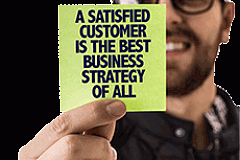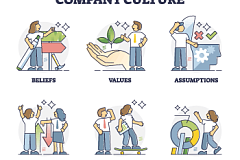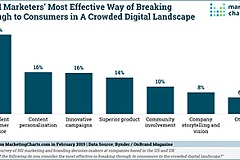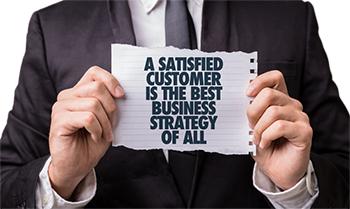 One of the most important factors in entrepreneurial success is attracting and retaining customers. To achieve this, business owners need to focus on how they treat clients, whether they are fulfilling the customers’ expectations, and if the user experience is everything they – and their clients – need for it to be.
One of the most important factors in entrepreneurial success is attracting and retaining customers. To achieve this, business owners need to focus on how they treat clients, whether they are fulfilling the customers’ expectations, and if the user experience is everything they – and their clients – need for it to be.
As we continue our series on customer service, this month we’ll focus on how you can build a customer-centric culture in your business, using the core values and principles we identified last month.
Know Your Customers
Knowing your customers is vital to enable you to know what your customers want and need. Re-examine your customer personas to find out if you have all the necessary data, and if not, identify a way to collect it. You need to understand:
- How they think,
- What their pain points are, and
- How they want to be treated.
[quotesright]What actions can you take to deliver a better experience to customers dealing with your company? [/quotesright] Identify your customers’ expectations, then raise the bar to ensure your employees always do more than is required of them.
Set Your Goals
Identify what you want to achieve with your customer service principles and create parameters that reflect this.
- How often should your staff have contact with clients?
- How long should it take for them to make contact?
- What timeframe is reasonable for accepting returns?
- How long should a worker take to resolve a client query or complaint?
[quotesright]It’s easy to tell your employees to serve clients well, but what does that actually mean? [/quotesright] Deciding ahead of time on these criteria will give you a standard to work to, and a deliverable to measure against.
Develop a Motto
No matter how thoroughly you train your employees to focus on customer-centricity, few factors will remind them of this as much as a well-learned in-house motto or slogan. Instead of trying to get staff to remember multiple core values on the spur of the moment, articulate your customer-centric philosophy in a few meaningful words they can memorize easily.
Here are examples of customer-centric mottos:
- The luxury Ritz-Carlton beach resort in Naples, Florida: [quotesright] “We are ladies and gentlemen serving ladies and gentlemen.” [/quotesright] It might be a bit outdated now, but you get the drift.
- The renowned Mayo Clinic: “The needs of the patient come first.”
- Disneyland: “The happiest place on earth.”
Use the words you choose for your motto everywhere, so your workers are constantly aware of them, internalize them, and learn to live them. Your slogan should represent your philosophy and express it in a few clear, memorable words.
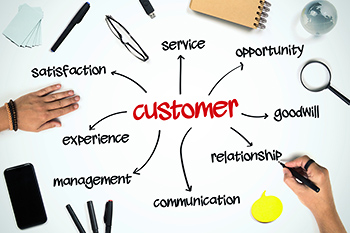 Continually Reinforce Commitment
Continually Reinforce Commitment
There’s a reason why most religions advocate starting the day with ceremony, meditation, or prayer. It’s so their followers can collect their thoughts, focus them on the central philosophy, and recommit to action.
Emulate this idea by using every possible opportunity to vocalize your motto. [quotesright]Highlight one core value each day or week during regular meetings. [/quotesright] Bring it to life visually through images, wall posters, email signature taglines and other reminders and make it part of your employees’ workday.
Hire, Train and Reward
Recruit staff who have a customer-centric focus. Make it part of the job specification and ask about it during interviews. Develop training programs for new hires and existing staff that cover every possible scenario in customer service and how to handle them.
[quotes]Link your employees’ growth and incentives to your customer satisfaction index. [/quotes]Reward those employees who go the extra mile to resolve customers’ issues, or to deliver an idea or service that makes end-users happier. When workers have a personal stake in an issue, it supports a culture where everyone strives to please the client and top performers aren’t determined by sales figures alone.
Measure Results
Design methods to measure customer satisfaction, so you can get a handle on how well you’re doing and identify areas requiring attention. [quotesright]Just because you don’t get many complaints does NOT mean your clients are all happy. [/quotesright]
Use surveys to obtain qualitative and quantative results and get specific feedback comments. Monitor repeat purchases and client history to find patterns. Implement follow-up phone calls from service staff to clients within a specific timeframe after a transaction.
Examine every touch point with a customer to see if it connects with the previous and following touch points. Ensure you cover any gaps in the service, while avoiding all but minimal overlap. This reduces the frustration that arises from duplication or the problems that develop when things “fall through the cracks.”
As Amazon CEO Jeff Bezos famously said: “We see our customers as invited guests to a party, and we are the hosts. It’s our job every day to make every important aspect of the customer experience a little bit better.” Since Amazon has managed to rack up the reputation of being the most client-centric company on earth, it’s possible Bezos is onto something.
[quotesright]Customer dissatisfaction can result in huge financial losses and long-term costs. [/quotesright] Building a customer-centric culture, however, has the completely opposite effect. It provides direction for your employees’ efforts, results in improved customer retention, and ultimately delivers monetary gains.
For help identifying your core values, developing a client-centric culture or designing training programs for your staff, contact me today. We have the training and experience to help.
Resources:
https://www.forbes.com/sites/micahsolomon/2014/07/20/customer-centric-culture/#658cc5cc7582
https://www.ameyo.com/blog/improve-customer-experience
https://www.salesforce.com/blog/2016/12/core-principles-customer-centric-organization.html
http://www.insightsfromanalytics.com/blog/bid/391487/How-to-Measure-Customer-Satisfaction
https://hiverhq.com/blog/customer-centric-organization/





